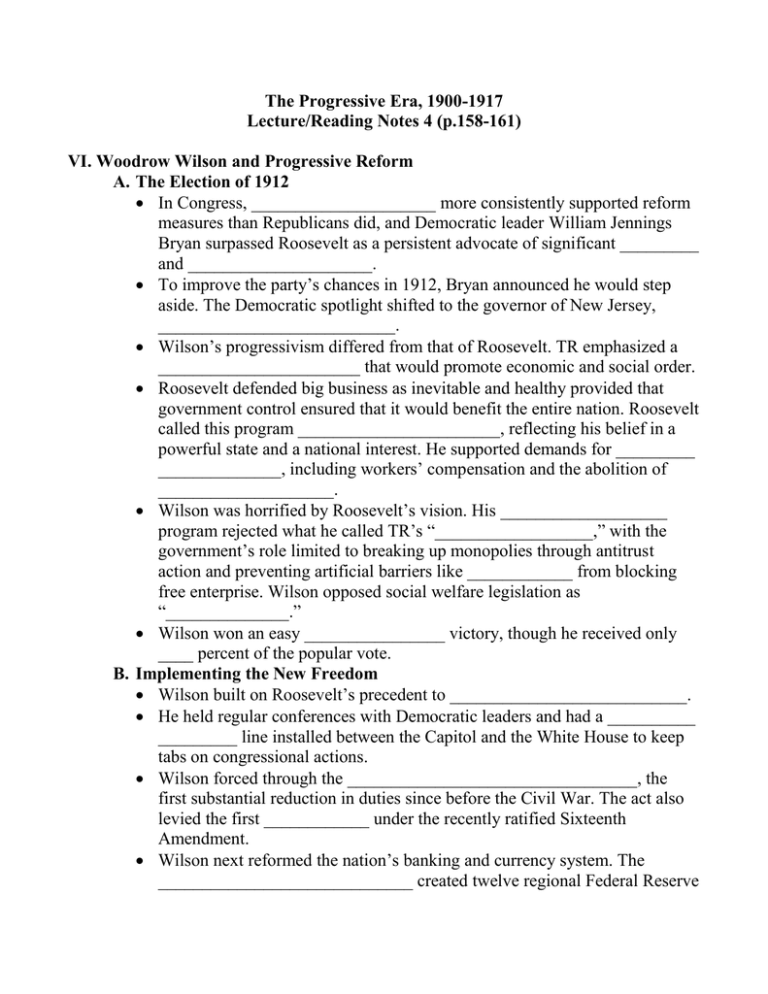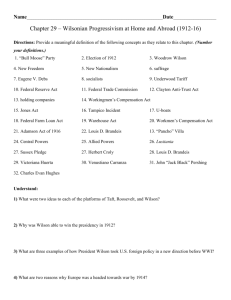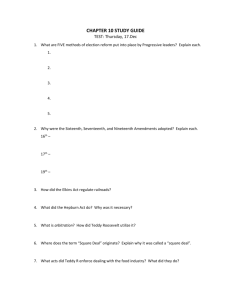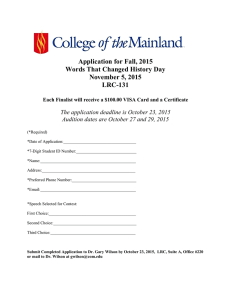The Progressive Era, 1900-1917 Lecture/Reading Notes 4 (p.158-161)
advertisement

The Progressive Era, 1900-1917 Lecture/Reading Notes 4 (p.158-161) VI. Woodrow Wilson and Progressive Reform A. The Election of 1912 In Congress, _____________________ more consistently supported reform measures than Republicans did, and Democratic leader William Jennings Bryan surpassed Roosevelt as a persistent advocate of significant _________ and _____________________. To improve the party’s chances in 1912, Bryan announced he would step aside. The Democratic spotlight shifted to the governor of New Jersey, ___________________________. Wilson’s progressivism differed from that of Roosevelt. TR emphasized a _______________________ that would promote economic and social order. Roosevelt defended big business as inevitable and healthy provided that government control ensured that it would benefit the entire nation. Roosevelt called this program _______________________, reflecting his belief in a powerful state and a national interest. He supported demands for _________ ______________, including workers’ compensation and the abolition of ____________________. Wilson was horrified by Roosevelt’s vision. His ___________________ program rejected what he called TR’s “__________________,” with the government’s role limited to breaking up monopolies through antitrust action and preventing artificial barriers like ____________ from blocking free enterprise. Wilson opposed social welfare legislation as “______________.” Wilson won an easy ________________ victory, though he received only ____ percent of the popular vote. B. Implementing the New Freedom Wilson built on Roosevelt’s precedent to ___________________________. He held regular conferences with Democratic leaders and had a __________ _________ line installed between the Capitol and the White House to keep tabs on congressional actions. Wilson forced through the _________________________________, the first substantial reduction in duties since before the Civil War. The act also levied the first ____________ under the recently ratified Sixteenth Amendment. Wilson next reformed the nation’s banking and currency system. The _____________________________ created twelve regional Federal Reserve banks that, although privately controlled, were supervised by the _________ ____________________, appointed by the president. Opting for continuous federal regulation rather than for the dissolution of trusts, Wilson endorsed the creation of the ___________________________ (FTC) to oversee business activity and prevent illegal restrictions on competition. C. The Expansion of Reform 1. Legislation designed to help farmers and labor In 1916, Wilson convinced Congress to pass the _________________ __________, which provided farmers with federally financed, longterm agricultural credits. Wilson and the Democratic Congress also reached out to labor. Wilson signed the _________________________ prohibiting the interstate shipment of products made by __________________. In 1916, Wilson broke a labor-management impasse and averted a railroad strike by helping pass the ____________________ establishing an _________________ workday for railway workers. Wilson pushed the _____________________, which achieved the progressive goal of ________________________ system for federal employees. 2. Louis Brandeis’ appointment to the Supreme Court Known as the “__________________,” Brandeis had successfully defended protective labor legislation before the conservative judiciary. Brandeis was the _______________ nominated to the court, and antiSemitism motivated some of his opponents. Wilson overcame a vicious campaign against Brandeis and ________________________. Wilson had brought progressivism to a culmination of sorts and consolidated reformers behind him for a ________________.




